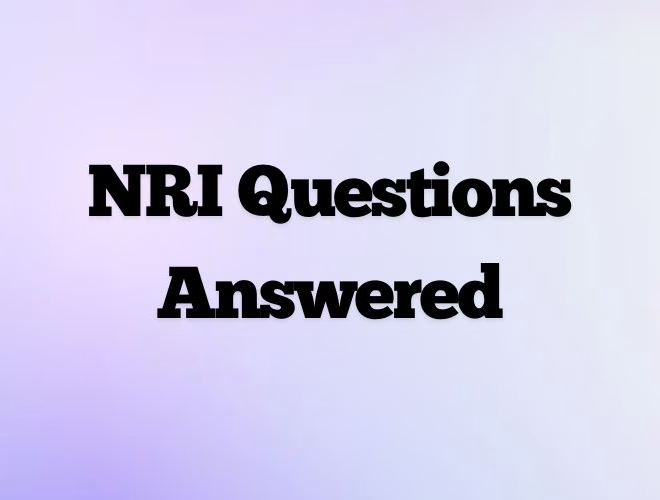This Article was fact checked and last updated for accuracy on October 29, 2025 by Mani Karthik
When I was planning my return from the US in 2017, I spent hours on the phone with my bank in India. The representative kept throwing around terms like NRE and NRO. I had no idea what she was talking about.
I ended up opening the wrong account first. Cost me some tax headaches later.
Let me save you that trouble.
What These Accounts Actually Are
Think of NRE and NRO as two different buckets for your money. Both are for Non Resident Indians. But they serve completely different purposes.
NRE Account (Non Resident External)
This is for money you earn outside India. Your salary from Dubai. Your consulting income from Singapore. Money from selling your house in California.
The money comes from abroad. Goes into this account. That’s the simple rule.
NRO Account (Non Resident Ordinary)
This is for money you earn in India. Rental income from your Bangalore apartment. Dividends from Indian stocks. Interest from fixed deposits.
The money originates in India. Stays in this account.
The Real Differences That Matter
Here’s what actually impacts your life:
| Feature | NRE Account | NRO Account |
|---|---|---|
| Tax on Interest | Zero tax in India | Fully taxable at your slab rate |
| Repatriation | Unlimited. Move money out freely | Limited to USD 1 million per year |
| Joint Holder | Only another NRI | Can be a resident Indian |
| Currency | Maintained in rupees but represents foreign funds | Only rupees |
| Tax Deducted at Source | No TDS | 30% TDS on interest |
| Best For | Foreign salary, savings, pension | Indian rental income, dividends, interest |
My Personal Experience
When I moved back in 2017, I made a classic mistake. I converted my NRE account to a regular resident account too quickly.
Bad move.
I should have kept it active for at least six months. Why? Because I had some consulting payments coming from my US clients. Those went into my new resident account. Created unnecessary tax complications.
My CA spent hours sorting it out.
Which Account Should You Open?
Open an NRE account if:
You’re still working abroad and want to park your foreign earnings in India. You might want to move money back out later. You don’t want tax hassles on the interest earned.
My friend Priya kept her NRE account active for two years after returning. Smart woman. She was unsure if the move would be permanent. The flexibility helped her sleep better.
Open an NRO account if:
You have income sources in India while living abroad. Rental property. Parents transferring money to you. Business income from India.
You can’t avoid this one if you have Indian income. The tax department wants to track it.
Open both if:
You’re like most NRIs. You earn abroad but also have some Indian income sources. That was my situation. Salary in the US. Rental income from my Chennai flat.
Two accounts. Clean separation. Easy tax filing.
What Happens When You Return for Good
This is where it gets interesting.
Within six months of becoming a resident again, you need to convert these accounts. I learned this the hard way.
Your NRE account can become:
- Regular savings account
- RFC account (Resident Foreign Currency account) to keep funds in foreign currency
Your NRO account must become:
- Regular resident account
The RFC option is brilliant if you think you might move abroad again. I wish I had known about it earlier.
Common Questions I Get
Can I have both NRE and NRO accounts at the same time?
Yes. I had both. Most NRIs do.
Can my wife in India be a joint holder?
Not on your NRE account. She needs to be an NRI too. But yes on your NRO account. This helps if she needs to access funds for property maintenance or emergencies.
What about my US born son’s account?
Here’s the catch. If your child was born abroad but you’re planning to return, check their residential status carefully. My younger son was born in California. We had to get proper documentation before opening accounts for him.
The Tax Angle Nobody Talks About
NRE interest is tax free in India. But here’s what nobody tells you.
If you’re a US person (citizen or green card holder), you still need to report this income to the IRS. Yes, even the tax free Indian interest.
FATCA compliance is real. The banks report your accounts. Don’t try to hide anything.
I spent USD 500 on a cross border CA to sort this out. Worth every penny.
My Top Tips After Seven Years
Keep detailed records. Every transfer. Every conversion. Save the bank certificates. You’ll need them for ITR filing.
Don’t rush the conversion. When you return to India, keep your NRI accounts active for at least six months. Sort out all pending foreign transfers first.
Use the right account for the right purpose. Don’t mix foreign income with Indian income. Clean books make life easier.
Plan your repatriation. If you have large amounts in your NRO account, plan the USD 1 million annual repatriation limit carefully.
Get a good CA. This isn’t DIY territory. I tried. Failed. Hired help. Much better.
When You’re Not Sure
Banking rules change. Tax laws evolve. Your situation is unique.
If you’re confused about which account to open, ask in our Facebook community. We have CAs, bankers, and people who’ve been through this journey. Real experiences. Real answers.
The wisdom of 16,000 members beats any blog post.
Sources and Further Reading
This information is based on current RBI and Income Tax guidelines as of 2024.
Key Sources:
Reserve Bank of India – FAQs on NRI Accounts
https://www.rbi.org.in/Scripts/FAQView.aspx?Id=26
Income Tax Department – Taxation for NRIs
https://www.incometax.gov.in/iec/foportal/
FEMA Guidelines – Foreign Exchange Management
https://www.rbi.org.in/scripts/BS_FemaNotifications.aspx
Always verify current rules with your bank and CA. Regulations change.


